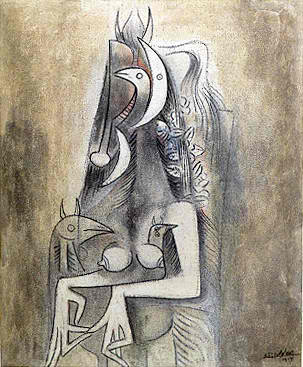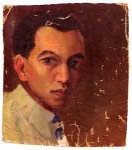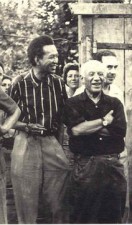
Wilfredo Lam
Cuban, 1902-1982 (active France)
The Casting of the Spell, 1947
oil on burlap
43 1/8 x 36 in.
SBMA, Gift of Wright S. Ludington
1956.2.4

Autoportrait , ca 1921, Oil on canvas, 21.3 x 24.0 cm
RESEARCH PAPER
THE ARTIST
Wifredo Oscar de la Concepción Lam y Castilla was born in Sagua la Grande, Cuba in 1902. His mother was of mixed African, Indian and European heritage; his father was Chinese. Later known as Wifredo Lam, he was raised a Roman Catholic, but was introduced early to the blend of African religions and Christianity called Santeria. For a young man of his racial background and social standing, a career in art was neither a practical pursuit nor in the best interest of his family. In 1916 he studied law at his family members' insistence, but began to spend more time in the botanical gardens of Havana drawing tropical plants than he did studying for rigorous law exams. His mother and father eventually acceded to his interest in art. Between 1921 and 1923, Lam studied painting at the prestigious Academia San Alejandro in Havana, a bastion of academic art that he eventually came to despise.
In 1902, racial discrimination had been declared illegal by the Cuban Constitution, yet many Afro-Cubans and Chinese "contract laborers" faced social and economic hardship, particularly in larger cities such as Havana. Stifled by his training as an academic realist at Academia San Alejandro, and with little hope of a social upheaval to liberate an unequal society, Lam secured an educational grant in 1923 that allowed him to enroll at the art school of the Prado Museum in Madrid.
While in Madrid, Lam's work demonstrated competent interpretation of European academic traditions. He was exposed to a wealth of art history, and was especially appreciative of the Dutch, Flemish, and Spanish painters dating back to the fifteenth century. Lam was introduced to the prehistoric and archaic art exhibited at the Museo Etnológico, where he became acquainted with the sculptures of the Congo and Guinea. But it was the viewing of Picasso's work firsthand that truly left an artistic imprint on the artist's stylistic development. As Lam would reflect later:
The first time you look at a picture by Picasso. You are surprised by the energy of the form . . . more than all the artistic achievement of the old masters . . . what mattered to me was communication. And it was in front of Picasso's work that I at last understood: a picture is a proposal to others. 1
Once again, political and social circumstances of the time were cause for flight. After fighting on the side of the Republicans in the Spanish Civil War, Lam left Spain for Paris. After Lam moved to Paris in 1938, Picasso's Demoiselles d'Avignon truly influenced his work, most notably in La Jungla, considered his masterpiece, which he would paint in 1942-43. Lam found an enthusiastic supporter and lifelong friend in Picasso.
In Paris, he also became involved with members of the Surrealist movement, whose transformative vision and expression of the unconscious mind in art and literature resounded with Lam's cultural, political, and social ideals. After fleeing a German-occupied Paris in 1940, Lam met up with André Breton and other Surrealist artists who had settled in Marseilles.
Although safely out of Paris, Lam was among a group of dissident intellectuals who were Nazi targets. In 1941, the Emergency Rescue Committee secured passage to Cuba for him and Helena Holzer, who became his second wife.
During the early 1940s in Cuba, Lam struggled with a number of influences that eventually evolved into his signature style: lively patterns (suggesting Matisse), deliberate lines of fragmented female figures (hinting of Picasso), and elements of totemic Santería divinity (birds, plants, animals). In fusing these uniquely different styles, Lam managed to express his ethnic identity and knowledge of Afro-Cuban culture by using the conventions (i.e., Surrealism and Cubism) of European modernism).
In Cuba, he reestablished his connections to the intelligentsia. Although Lam did have acquaintances within the Cuban avant-garde, and even intimate associations with Cuban modernists such as Teodoro Ramos Blanco and Amelia Peláez, he refused to be defined as a Cuban or Latin American artist and was extremely selective in his choice of exhibitions.
This was a transitional time for Lam. While beginning to withdraw gradually from the Cuban art scene, he reestablished prewar contacts in Europe, and established new ones in New York. Between 1946 and 1952, he traveled extensively between Cuba and Europe, naturally passing through New York. There he reconnected with Breton, who helped negotiate the first exhibition of his work at the Matisse Gallery in New York City. As a result of this initial showing, Lam's reputation in the New York art scene grew. In 1946 alone, he had solo exhibitions in Port-au-Prince, Havana, London, and Paris, and he participated in group shows in New York, Cuba, Paris, and Mexico City.
By 1952, Lam returned to Paris; by 1960, he established himself permanently in Italy. In later paintings he remained true to his earlier imagery while exploring simpler forms and richer colors. Lam also experimented with ceramics and sculptures in the round, for casting in metal, of mythological figures similar to those in his paintings. In the years following the Cuban Revolution (1953-59), he maintained contact with friends and family in Cuba. His last visit to the island took place in 1980 while in poor health. He died two years later in Paris.
THE CASTING OF THE SPELL
In The Casting of the Spell, Lam has created a surreal human and animal hybrid. He painted this figure on burlap, using the same techniques as with his drawings: the surface was stained with turpentine and paint before he began his work in oil on charcoal drawings. The texture of the burlap helps contribute to the other-worldliness, menacing feel of the work, and also helps present this painting in the context of a primitive style.
Within this amalgamation of human, plant, and animal emerges objects of the organic world of nature and the transformative elements of Santería. A bird sits atop a woman's head, signifying the divine life force. The heads of two horned birdlike beings appear to emerge from this figure's body; most notably, the one that seemingly forms part of her right elbow. Birds appear throughout Lam's work, whether they are symbolic of deities, diabolical creatures, or sacrificial offerings, just to name a few. What they represent here--whether dove or cock, peace or fight--cannot be said for certain. But within the context of the painting, cock and fight most likely embody and dominate the spirit of the piece. In The Casting, the horns on these birds are open to interpretation; that being said, in many of Lam's works, these spiked forms are perhaps a symbol of masculinity. Horns also appear on the apex of the fusioned figure, suggesting an aura of evil and cruelty.
The crescent-shaped forms are what can be considered representational interpretations of African or Caribbean masks. Fruit-shaped breasts, a horse's tail jutting from the back of the head, in juxtaposition with a loosely flowing mane (entangled with natural fishlike and leaf shapes), and elongated fingers are all Afro-Cubo elements that emerge from this Cubist-style figure.
It is oft debated as to whether Lam is an outsider of the European modernist style or whether Lam is essentially an Afro-Cuban artist making critical use of modernist conventions to achieve a "profound act of disruption" with the West. As Rufino Tamayo noted:
[Lam] has created his own balance between Latin American art and the school of Paris." 2
Prepared for the SBMA Docent Council by Marianne Maggini, 2007.
Footnotes
1 Max-Paul Fouchet, Wifredo Lam , 108.
2 Thomas Hess, "Spotlight on Lam," Art News 14 (May 1948), p. 37.
Bibliography
Atkins, R. (1990). ArtSpeak: A guide to contemporary movements and buzzwords. New York: Abbeville Publishing Group.
Cellini, Margie. (December 1993) Wifredo Lam and Personaje . Retrieved February 27, 2007, from http://www.sbmadocents.org.
Cotter, H. (1992). Review/Art; A Mulatto-Chinese Cuban with a gift for fusion. Retrieved March 4, 2007, from http://query.nytimes.com/gst/fullpage.html

Wilfredo Lam and Picasso in France in 1963.
COMMENTS
Wilfredo Lam, The Casting of the Spell, 1947, oil on burlap. SBMA, Wright S. Ludington (1900-1993), founding trustee and donor for over 50 years, gave us this piece in 1956. As a core work of our Latin American Collection, it is a delight to again view it in Serenity and Revolution curated by James Glisson. The spell it casts merges the artist’s Afro-Cuban roots, the Santería blend of Catholicism and African identification with nature. Wilfredo Lam’s deep anti-colonialism and interest in surrealism drew him to Europe. His first view of a Picasso painting revealed for him the meaning in art. The Casting of the Spell merges the orisha priestess with the foliage and animal world, a fin extending down her back, a budding horned crown hovering above the red of her internal fire. The cubist flare and grace of her moving hands casts its spell through the primitive burlap surface.
- Ricki Morse, La Muse, April 2024
SBMA CURATORIAL LABELS
After spending time in Paris and meeting Picasso and the Surrealists, Lam fled France in 1941 because of the Nazi invasion. He returned to his native Cuba and explored the nation’s Afro-Cuban history. This painting refers to Santería, which combines elements of African religions and Catholicism. Lam’s maternal grandmother was an enslaved person from the Congo, and his father was a Chinese immigrant to Cuba. Lam saw his painting as a tool to combat the forces of colonialism, and he viewed his art as aligned with the liberation movements that led to many peoples declaring their independence from the European colonial powers.
- Serenity and Revolution, 2024
Wifredo Lam was born and raised in Sagua la Grande, a village in the sugar farming province of Villa Clara, Cuba. His father was a Chinese immigrant and his mother was of African descent. His godmother, a Santería priestess, exposed Lam to rites of the orishas, or deities, as a child. Santería, the Afro-Cuban religion blending aspects of Catholicism and traditional West African beliefs, was a powerful force manifest in much of his work.
Lam left Spain for Paris in 1938 after fighting in the Spanish Civil War on the Republican side, defending Madrid. In Paris, he met Picasso, who became a friend and an enthusiastic supporter of his work, introducing the artist to Joan Miró, Fernand Léger, Daniel-Henry Kahnweiler, and others. The following year, Lam became associated with the Surrealists after meeting André Breton in 1939.
Upon returning to Cuba in 1941, after such a long absence, Lam was struck by the plight of the black population and the degradation of Afro-Cuban culture for the tourist market. He set out to express their spirit and religious beliefs in a style influenced by Cubism and Surrealism. The Casting of the Spell is characteristic of the artist’s hybrid style applied to equally inventive figures composed of human, animal, and vegetal elements inspired by the attributes of Santería orishas.
SBMA title card information 2013
After meeting Picasso in Paris in 1938 and joining the Surrealist movement in 1939, the Cuban-born Wifredo Lam began synthesizing the broken plane of Cubism with the metamorphosed figure of Surrealism. From his Personages series, The Casting of the Spell is characteristic of the Picassoesque Cubo-Surrealism that Lam developed for his inventive hybrid figures of the 1940s, after World War II forced his return to Cuba.
The human-animal subject is situated in a Cubist space in which its stylized anatomy is fragmented and depicted from varying points of view. At the same time, this bewitching spellbinder—with its horned headdress and expressive hands that speak silently through signs—demonstrates Lam’s fascination with his native culture. The figure represents a shaman appropriated by Lam from Santería, the Afro-Cuban religion that blends aspects of Catholicism with traditional African beliefs.
SBMA Wall Text 2000
Wifredo Lam was born and raised in Sagua la Grande, a village in the sugar farming province of Villa Clara, Cuba. His father was a Chinese immigrant and his mother was of African descent. His godmother, a Santería priestess, exposed Lam to rites of the orishas, or deities, as a child. Santería, the Afro-Cuban religion blending aspects of Catholicism and traditional West African beliefs, was a powerful force manifest in much of his work.
In 1923, Lam left Cuba to further his studies in Madrid. He left Spain for Paris in 1938 after fighting in the Spanish Civil War on the Republican side, defending Madrid. In Paris, he met Picasso, who became a friend and an enthusiastic supporter of his work, introducing the artist to Joan Miró, Fernand Léger, Daniel-Henry Kahnweiler, and others. The following year, Lam became associated with the Surrealists after meeting André Breton in 1939.
- Ridley-Tree Gallery 2016
